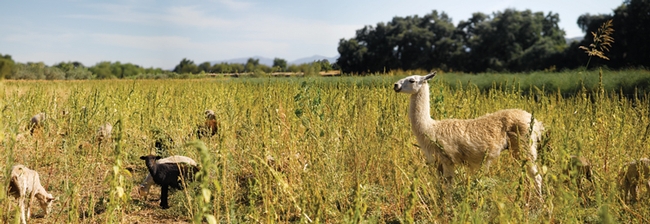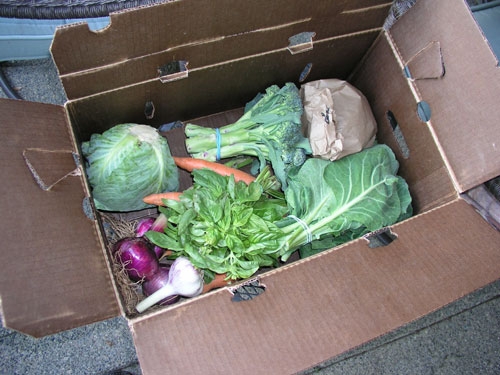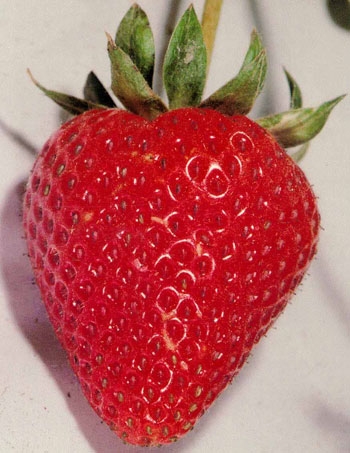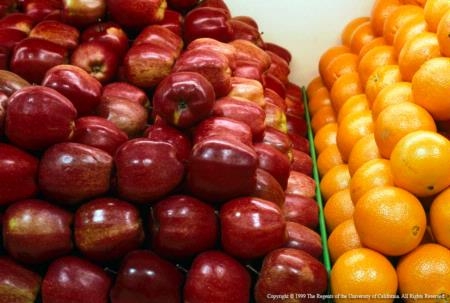UC Food Blog
Feed big; start small
Adapted from an article by Eileen Ecklund in Breakthroughs magazine.
But a group of UC Berkeley scientists say that continuing on our current path of industrial agriculture is simply not sustainable, given its enormous water, energy and chemical inputs, together with the new challenges posed by climate change, such as temperature and precipitation extremes.
With the launch of the interdisciplinary Berkeley Center Diversified Farming Systems late last year, UC Berkeley scientists are coalescing around a set of biodiversity-promoting farming practices they say are a promising solution.
Claire Kremen, a conservation biologist and associate professor in the Department of Environmental Science, Policy and Management, says that most or even all of the inputs that modern commercial farms require — chemical pesticides and fertilizers, wasteful amounts of water and energy, imported pollinators — were needed only because the monoculture-dominated landscapes created by industrial agriculture lacked biodiversity.
"From studying the pollinators, I realized that the way we conduct agriculture has basically required us to replace all of the ecosystem services that used to be in the agricultural ecosystem with substitutes," said Kremen, a 2007 MacArthur Fellow.
Generally speaking, a diversified farming system is one that promotes biodiversity across spatial scales, from plot to field to landscape. Crops are planted and livestock raised in combination, resulting in interactions that sponsor the functioning of the farming systems in ways that replenish natural ecosystems. Methods employed within a diversified farm may include minimal soil tillage, growing multiple crops together, planting cover crops, and interspersing trees and shrubs with crops and livestock.
These practices also provide pollination, pest and disease control, water purification, and erosion control. They help to build healthy, productive soil and reduce water use, as demonstrated by research conducted by Kremen and her Berkeley colleague Miguel Altieri in their respective labs and on farms in Napa, Sonoma, and Yolo counties.
But diversified farming systems aren't just about providing food and protecting the environment; to be truly sustainable, they must also provide a livelihood to farmers and farm laborers, and help support the communities that depend on them. UC Berkeley-based Cooperative Extension specialist Christy Getz has studied farm labor conditions and food security among agricultural workers. In one project, her team developed a program to help Southeast Asian refugee farmers in California scale up their operations, connect to alternative distribution systems, and access new markets for their produce, such as local schools.
Professor Alistair Isles focuses on the public policy, science policy, and sociological dimensions of making a switch back to diversified systems from industrial agriculture in developed countries. For example, he has studied the importance of innovative consumer tools that promote sustainable agriculture such issues as "food miles"—the distance that food travels from farm to table—and sustainable seafood evaluation methods.
If farmers could bring back many of the traditional practices that supported biodiversity, enhanced by the application of modern ecological science, Kremen believes that the world could produce more food while reducing agriculture's harmful effects, making it more sustainable over the long term.
And unlike organic agriculture, diversified farming systems are not an all-or-nothing approach; Kremen says farmers can implements all the systems the Berkeley center recommends based on its research, or simply implement selected techniques, such as planting native-plant hedgerows or using soil-enriching cover crops, and still make their farms more sustainable.
Community supported agriculture prospering in Central Valley
Community Supported Agriculture (CSA) – a way of buying fresh produce and other foods directly from farmers – is growing rapidly in California’s Central Valley, according to a newly published study in the California Agriculture journal.
Membership in the CSAs surveyed for the study increased from an estimated 672 in 1990 to 32,938 in 2010.
The growth in Central Valley CSAs is one part of a bigger movement toward stronger direct relationships between farmers and consumers, said Ryan Galt, UC Davis assistant professor in the Department of Human and Community Development and co-author of the study “Community Supported Agriculture is thriving in the Central Valley."
“Consumers increasingly want to connect with the farmers who grow their food,” Galt explained, while unpacking a cornucopia of vegetables from his own CSA box. “Food is an intimate thing, so I don’t think it’s strange that people want to establish relationships with those who produce it.”
While Galt’s study focuses on the farm, rather than consumer, side of the relationship, he said he joined a CSA for several reasons.
“I wanted to support a more ecologically oriented agriculture, and the livelihoods of farmers and farmworkers. And then, there is the benefit of not having to shop as much,” he added, snipping a bunch of deep purple beets from their greens.
It’s beet season in California. The dark root vegetable is relatively new to Galt’s culinary repertoire. Had it not shown up in the first CSA box to which he subscribed, years ago, he might never have learned to prepare it and would unlikely order it on a menu. The surprise and challenge of preparing new, interesting foods is among the reasons Galt still subscribes to a CSA.
Like most California CSA members, Galt picks up a basket of produce from a central location, not necessarily the farm itself. Some CSA farms deliver directly to homes. Few require members to visit the farm, but most host member events.
“CSA farmers provide their members more than food. They offer a direct connection to what is happening on the farm and with the seasons, they educate their members on agricultural and rural issues, and they share recipes that help members use their food,” Galt said, sliding a pot of beets into the oven.
It’s a lucrative exchange for CSA farmers, he adds. Average gross sales per acre for CSA farms is six times greater than average CA farms. Because people subscribe to their farm in the same way people subscribe to magazines, CSA farmers have a good idea how much to produce and harvest, and, most importantly for them, they have a promised market and up-front cash. Many young farmers are creating CSAs because of these benefits.
“CSA farmers are motivated by their love of farming and the satisfaction of providing fresh produce to grateful members,” Galt said.
Roasted beets
6 medium beets
2 tablespoons balsamic vinegar
2 teaspoons orange zest
Pepper
Preheat oven to 350 F. Wash the beets and put the unpeeled in a roasting pan with about an inch of water. Cover and bake for an hour, or until they are easily pierced with a folk. Slip off the skins after the beets have cooled. Slice the beets into wedges. Toss with vinegar, orange zest and pepper. Serve at room temperature.
Can smartphones help us eat smarter?
Nowadays, there are apps on our mobile devices that will do virtually anything. They help us get organized, give us the news, entertain us, help us plan trips and allow us to connect with friends. One thing that has become apparent as I peruse the online app store for my latest download is that there are many, many apps devoted to food, nutrition, health and most importantly - weight loss. The apps count calories, suggest healthier foods, encourage exercise, plan meals and provide useful grocery shopping tips. With boundless technology literally at our fingertips, I wonder if apps can actually help the average smartphone-wielding consumer make smarter, healthier eating decisions.
What does the research show?
Students at Cornell University took part in a study where they were given a mobile phone app and asked to take photos of anything they do or don’t do that might be considered good (such as taking the stairs) or bad for them (such as making a late-night fast food run). They uploaded these photos into the mobile app then rated them based on their healthfulness. They were asked to do this at least five times a day. They could all review their previous posts and a portion of the participants could view posts uploaded by their peers. Most participants reported increased health awareness and self-control at the end of the study, particularly among the group that could see photos taken by their peers. The study was only two weeks long, and didn’t lead to any real behavior change, but the researchers believe there is potential for more significant change after long-term use of the app.
Taking matters into my own hands…
Armed with a smartphone and some reusable shopping bags, I set out to my local grocery store to conduct a food shopping experiment of my own. Prior to going to the grocery store, I downloaded a few free apps onto my iPhone that I thought would be useful on this shopping expedition.
Since saving money on groceries is high on my list of priorities, I downloaded the Food on the Table app, which claims to be a better way to plan meals and save money. After filling out a short profile, the app helped me plan a meal, organize a grocery list and take advantage of in-store coupons within minutes. I chose to make the butternut squash and black bean enchiladas recipe, and navigated the grocery store with my cell phone in-hand to find all of the necessary ingredients. As I perused the tortilla display, I made use of another app that I downloaded, the Shop Well app, to help me choose the healthiest option among the multitude of tortillas available in the grocery store. With this app I could scan barcodes of the various tortillas and was given a personalized food score of each product based on a profile I filled out earlier (listing my health goals and any medical conditions). One package of tortillas turned up as a “medium” match for me. The app suggested another type of tortilla that would be a better match for my goals. Meanwhile, the Food on the Table app was telling me about a brand of tortillas that was on sale on that particular day. Of course they weren’t the same, so I opted for the healthier product over the on-sale product because the difference in price was marginal.
Next, I went home and prepared the meal following the directions on the app. After preparing the meal, I served up my plate of food and took a picture to upload into the Pic Healthy Photo Food Diary app. With this tool, I could upload my photo and rate how healthy (or unhealthy) my meal was, and let friends also be the judge (see pic on right). The idea is that friends can either cheer me on for making a healthy decision or call me out for a not-so-healthy meal choice. I’m still waiting for someone to rate my meal, but I can see how this could be fun and motivational if my friends were also participating, and we were all encouraging one another to reach our health and wellness goals.
I then used the Lose It! app to keep track of what I was going to eat and to determine the amount of calories in my meal. I entered every ingredient into the recipe section and came up with a calorie count and nutrient breakdown for the meal I was about to consume. Granted, it was a little tedious, but a great process that made me really think about what I was about to eat. If I continue to use this app, I will certainly think twice the next time I chow down on a big meal or snack.
The meal I chose to make ended up being far too spicy for my taste (if only the app rated the meal based on heat!). Despite this unfortunate setback, the process was educational – and dare I say FUN? It’s unlikely that I will go back to the grocery store and use my phone to scan products to identify healthy options (it’s far easier to use basic nutrition know-how to make these decisions – make half your grains whole, choose foods low in saturated fat, eat more fruits and vegetables, etc., etc). But I definitely enjoyed the menu planning app and appreciated being able to have new recipe ideas at my fingertips (even if my first choice was a bit of a disappointment!).
If you’ve made it a goal to eat healthier, exercise more and possibly lose weight in the New Year, then why not give one of the many mobile apps a try. Even better, get your friends and family involved and download apps together that allow you to motivate one another to stick to your goals. With all this technology at your fingertips, eating smarter may have just gotten a little easier!
Mind your food
One morning more than a decade ago I tried an “eating meditation” in Silverlake, about an hour’s drive from UC Riverside. We were about ten people – more Buddhish than Buddhist – in a dark and quiet room, seated on stiff chairs around a menacing-looking table. Each of us was handed a strawberry and told to await instructions.
I had never participated in an eating meditation before. I wasn’t even sure what was involved. Did one eat and eat, and meditate at the same time with eyes closed? I had tried two other kinds of meditation before – sitting and walking meditations. A meditation focused on food intrigued me, and it was simple curiosity that motivated me to try it out.
The instructions, when they came, were simple: We could feel the strawberry, smell it, examine it closely, and, yes, eat it in micro-bites. What we had to ensure, however, was that this exercise was continuous, that we sat in place, and that we were still doing at least one of these activities at the end of a half hour. We could not gobble down the strawberry or ask for more. What would work best, if we were set on just the eating activity, was to nibble at it – preferably molecule by molecule. Needless to add, the focus of the silent meditation had to be the strawberry as far as possible, and nothing else.
The exercise was not easy. For the first few minutes some of us collapsed into giggles. Later, the exercise turned uncomfortable and awkward. But as the minutes dragged by at what seemed a glacial pace, the atmosphere in the room transformed, embracing a seriousness the meditation deserved. I remember letting piece after tiny piece of strawberry linger on my tongue until I had “exhausted” the taste of each. I also remember closely scrutinizing the texture of the fruit, letting my fingers caress the rough skin, feeling the pattern of what, to my surprise, turned out to be hexagons wrapping the fruit, and marveling over the berry’s geometry and symmetry.
Until that morning, I had not examined a strawberry with such concentration, such patience. I had paid little attention to the small seeds piercing the surface, and had only barely noticed how the red hue deepened from the flat top of the fruit to the conical peak. There were times when the strawberry felt heavy in my hand; at other times I had to gently squeeze the flesh to resurrect sensations and bring my mind back to the meditation.
After a while, so lost were we in the exercise that time seemed to cease and nothing in the world mattered more than the strawberry in hand. Indeed, the universe shrank – or had it expanded? – to just me, the strawberry and the meditation. Where I ended and the strawberry began was hard to say, and irrelevant.
After we emerged from the meditation, the recommendation we were offered was to do the exercise daily, starting with half an hour (we could increase the time with practice, if we wanted) and a food of one’s choice – anything small, such as a grape or a small candy. What was not said but unanimously understood was that this exercise could be an effective way to overcome excessive and mindless eating, the lesson being you didn’t need too much of a food you crave to enjoy it well.
To friends who tell me they wish to lose weight, I recommend the eating meditation. Even if it fails to reduce your weight, I inform them, the great benefit of the exercise is that you become mindful of what you eat, how much and for how long. To date, none of these friends told me they took on the challenge. Can I be surprised? Given how frequently food ads on TV, the print media, and elsewhere assail us, I cannot censure them. Sadly, here’s my confession: It has been many years now since I did this meditation.
For more information on mindful eating, read the February 2012 New York Time article Mindful Eating as Food for Thought.
Beyond New Year's resolutions: tips for good health
Oh January 1st, how I hate you. If you’re like me you’re still recovering from the month long holiday food hangover. With three months until spring and swimsuit season on the horizon, you’re feeling the pressure to lose the winter coat! As always, you make that infamous New Year’s resolution: TO LOSE WEIGHT!
“Gym membership here I come!”
“I will not touch another carb for the rest of the year!”
“No sweets ever again… after this one!”
“I’m on a new diet, I eat nothing and when I feel like I’m going to faint I eat a cube of cheese!”
Okay the last one is my favorite quote from the Devil Wear’s Prada, but working in the health field I have found that sometimes people actually think that’s a solution. We find ourselves making resolutions that eliminate entire food groups from our diets, because we think it will help us lose weight. The thing most people don’t know or realize is that sometimes the absolutes we make can be very harmful to our health, and in the long run can actually cause us to gain the weight back plus more.
So this year, let’s make an attainable, realistic goal. Here are three tips selected from www.choosemyplate.gov, to have a healthy year!
- Put a positive spin on it – instead of saying “I can’t eat any sweets at all!” try a few “I will” statements on for size:
- I will add 1 serving of fruits and vegetables to each meal.
- I will make half of my grains whole.
- I will choose water or low-fat milk more often.
- Build a healthy snack – instead of buying the expensive processed snacks, try these healthy tips:
Combine fruit and a dairy food for the morning munchies:
- Apple and cheese
- Banana and yogurt
Combine vegetables and a protein food for a p.m. pick-me-up:
- Celery and peanut butter
- Carrots and almonds
Combining these foods will help you stay fuller longer while increasing your nutrient consumption.
- Don’t discount physical activity – being healthy isn’t about just what you eat. Adults need 30 minutes of physical activity a day and children need 60 minutes. Just because you don’t have a gym membership doesn’t mean you can’t be physically active. Remember that 30 minutes can be broken up throughout the day.
Here are some tips to increase your physical activity incrementally, without breaking the bank:
- Start a walking club with your co-workers, neighbors or friends. You’re more likely to do it if someone keeps you accountable.
- Do what you like! If you hate to run, don’t do it. There’s no use in driving yourself crazy doing something you hate. If you like to dance, then turn the radio up and have fun!
- Do stretches, exercises, or pedal a stationary bike while watching television.
Remember to always consult your physician before beginning a rigorous exercise regimen.
May your new year be full of realistic, attainable, resolutions! Keep it positive. Select healthy snacks that help you stay full longer. Get moving so you have more energy during the day. For more information and health tips visit www.choosemyplate.gov.
Wishing you all a very healthy 2012!










